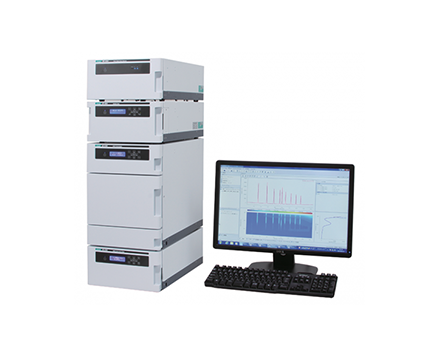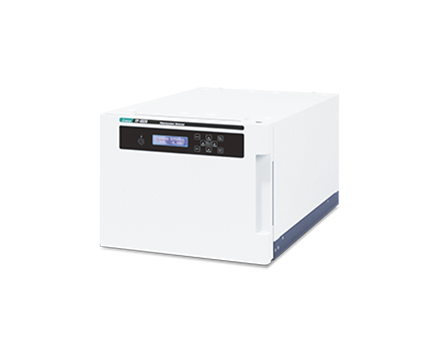Detection of Nitroarenes in Diesel Exhaust Using HPLC with UV and Fluorescence Detection
August 11, 2022
Introduction
A family of polyaromatic hydrocarbons (PAHs) known as nitroarenes are present in automobile exhaust. These species are known to be highly mutagenic and carcinogenic. Thus, it is very important to develop good methods for the analysis of these species. In many cases the presence of interfering compounds often masks the target compounds, making highly selective and sensitive detection difficult. In this experiment, an on-line reduction system and clean-up method is employed to enhance the fluorescence and provide higher selectivity. The system allows simultaneous analysis of PAHs and nitroarenes in diesel exhaust.
Experimental
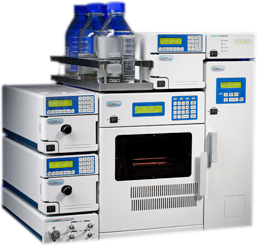
A series of diesel exhaust samples spiked with nitroarenes were run on a Jasco HPLC equipped with an NPpak-P pretreatment column, an NPpak column for separation, and an NPpak-R column for reduction. Samples were run using gradient elution with methanol and water at a flow rate of 1mL/min. Pretreatment and separation temperature was 40°C while the reduction was done at 100°C. A sample containing five standards, naphthalene, acenapthylene, acenapthene, fluorine, and penanthrene, and four diesel exhaust samples were run using an injection volume of 10µL and UV detection at 254nm. A fluorescence detector was used to monitor emission at 436nm with an excitation of 365nm.
Results
Figure 1 shows the chromatogram of the 5 component nitroarene standard. Using the HPLC system described above with fluorescence detection, all 5 components were able to be separated and detected. Figure 2 shows fluorescence detection of nitropyrene (NP) in diesel exhaust. Although a large number of species are detected, none of them interferes with the nitropyrene peak which elutes in approximately 23 minutes. A series of nitropyrene standards were spiked into a diesel matrix and the detection limit of nitropyrene was determined to be less than 1pg.
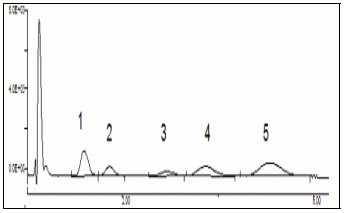
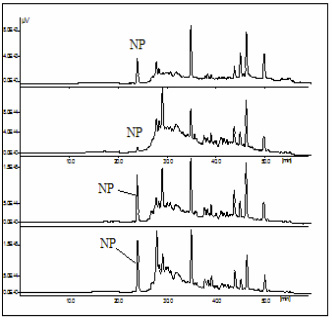
Featured Products:

Detection of Nitroarenes in Diesel Exhaust Using HPLC with UV and Fluorescence Detection
Introduction
A family of polyaromatic hydrocarbons (PAHs) known as nitroarenes are present in automobile exhaust. These species are known to be highly mutagenic and carcinogenic. Thus, it is very important to develop good methods for the analysis of these species. In many cases the presence of interfering compounds often masks the target compounds, making highly selective and sensitive detection difficult. In this experiment, an on-line reduction system and clean-up method is employed to enhance the fluorescence and provide higher selectivity. The system allows simultaneous analysis of PAHs and nitroarenes in diesel exhaust.
Experimental

A series of diesel exhaust samples spiked with nitroarenes were run on a Jasco HPLC equipped with an NPpak-P pretreatment column, an NPpak column for separation, and an NPpak-R column for reduction. Samples were run using gradient elution with methanol and water at a flow rate of 1mL/min. Pretreatment and separation temperature was 40°C while the reduction was done at 100°C. A sample containing five standards, naphthalene, acenapthylene, acenapthene, fluorine, and penanthrene, and four diesel exhaust samples were run using an injection volume of 10µL and UV detection at 254nm. A fluorescence detector was used to monitor emission at 436nm with an excitation of 365nm.
Results
Figure 1 shows the chromatogram of the 5 component nitroarene standard. Using the HPLC system described above with fluorescence detection, all 5 components were able to be separated and detected. Figure 2 shows fluorescence detection of nitropyrene (NP) in diesel exhaust. Although a large number of species are detected, none of them interferes with the nitropyrene peak which elutes in approximately 23 minutes. A series of nitropyrene standards were spiked into a diesel matrix and the detection limit of nitropyrene was determined to be less than 1pg.



 Download This Application
Download This Application